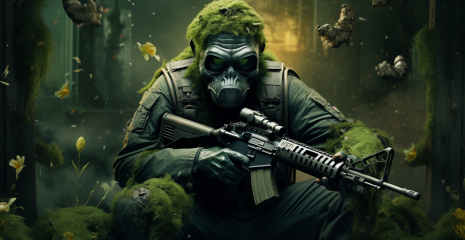

A conflict is brewing in South America that involves more than just disputes over territory. The flag war between Guyana and Venezuela symbolizes the deeper historical, cultural and political contradictions between the two nations. The article provides an overview of the history of this conflict, focusing on its roots and evolution since the colonial past of both countries.
Since December, Venezuela has held a controversial referendum on claims to the oil-rich Essequibo region controlled by Guyana. On the same day, Venezuelan Vice President Delsey Rodríguez posted a video on X, formerly Twitter, showing a group of indigenous people lowering the Guyana flag and raising the Venezuelan flag instead over the territory, which is also known as Guyana. Esequiba. “Glory to the brave people!” she wrote, which is the first line of the country’s national anthem.
The post comes after Guyana’s President Irfaan Ali released his own video on November 24th of himself attending the raising of the Guyana flag at the supposed border between Guyana and Venezuela. Bellingcat was first alerted to the posts by EsPaja, a fact-checking center in Caracas. You can read their analysis of the same incidents here in Spanish.
Venezuela has claimed Essequibo, which is two-thirds the size of Guyana, since the 19th century, and the country’s president, Nicolas Maduro, has been accused of stoking the issue to win popular support as he prepares to campaign for re-election next year. (The Venezuelan government has banned opposition leaders from running against it).

Tensions around Essequibo have risen in recent weeks, with Brazil moving troops to its northern border and the US announcing joint military exercises with Guyana. Since the raising and lowering of flags can indicate changes in territorial control, claims and counter-claims about these two videos are circulating online.
A popular interpretation among some Venezuelan and Latin American social media users is that the people in the video posted by Rodriguez removed the same flag that Guyana’s president raised in November.

Bellingcat was able to geolocate both videos in this remote area of the South American jungle. They actually show two different flagpoles located approximately 185 kilometers apart. When indigenous Venezuelans lowered Guyana’s flag, the event took place about 80 kilometers from the disputed border with Guyana and about 20 kilometers from Venezuela’s border with Brazil. Why the flag of Guyana was flying there at all remains unknown.
In a video released by Ali, the president of Guyana, he arrives in a helicopter on top of a mountain in the jungle. At the top of the flagpole is raised a group of soldiers saluting as the country’s flag, also known as the “Golden Arrow”. The president shared this video, which we’ll call Video One, on his Facebook page on November 24.
He added that the flag was raised “over 2,200 feet above sea level on our border.” Behind him, in the distance, flat characteristic mountain ranges can be seen. These are tepuis, which is the name of the tablelands and mountains common in western Guyana and Venezuela in the language of the indigenous Pemon people.

While analyzing claims about the location of these events, Bellingcat researchers came across the same video posted on the People’s Progressive Party Facebook page, which Ali represents. It appeared 39 minutes after the president released the video, and was captioned, “A golden arrowhead was raised this morning at the top of Mount Pakarampa.”
Footage from this video, showing soldiers posing with a large Guyana flag, was uploaded earlier this month to Google Maps for Mount Pakarampa.
However, the actual location was not on Mount Pakarampa itself, but instead can be traced to a nearby lookout point (6.35919,-61.13761). The flag was indeed raised on the territory of Guyana, east of the Venamu River, which is part of the border with Venezuela. The camera was pointing east, showing the Essequibo region of Guyana.
The scene of the soldiers posing with the flag is particularly useful given the mountain range in the background. Using a screenshot of the same scene – although not the one uploaded to Google Maps – provided useful clues. The location was verified using PeakVisor, an app originally designed for mountaineers.
Here, PeakVisor displays a virtual landscape of the same mountain range as in the first video:

By superimposing the silhouettes of this mountain range on the frame from Video One, we can see that they fit together. There are small differences due to the difficulty of matching the horizontal field of view (hfov) on the overlay image, but they are not significant enough to affect the match.
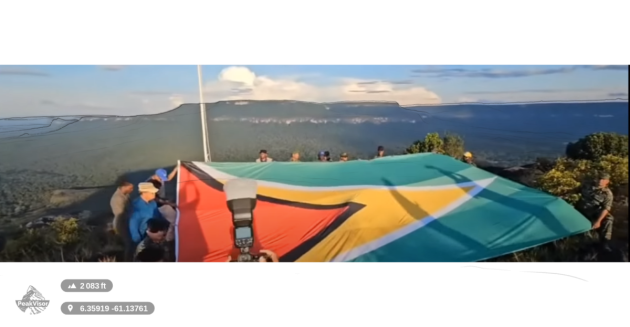
On December 11, AFP journalists visited the village of Arau and reported that local residents approved Ali’s raising of the national flag over a nearby mountain, which the newspaper did not name.
A group of indigenous people march to a flagpole with a large Venezuelan flag. In the next scene, the man declares December 3rd “a historic day” and that in Essequibo “this land is indivisible.”
Around him stands a group of people wearing T-shirts with an enlarged silhouette map of Venezuela, including the Essequibo region of Guyana. Although the text is illegible due to the low quality of the video, the colors inside the silhouette resemble the logo of “Venezuela Toda!” of the campaign that advocated a “yes” vote in the December 3 referendum.
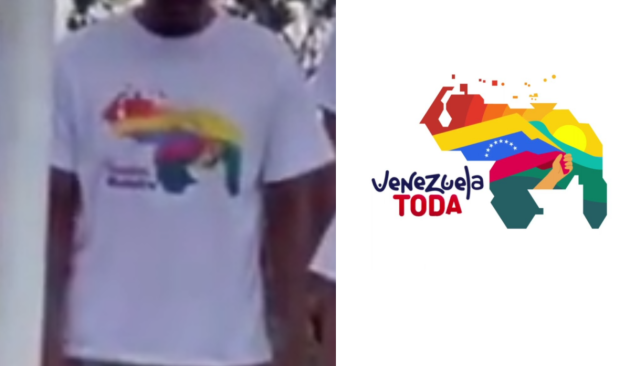
This video, which we’ll call “Video 2,” was posted on December 3 by Venezuela’s Vice President Rodríguez on X. El País reported that the video was released by the country’s Ministry of Communications — two Venezuelan cabinet ministers and the president of the National Assembly posted the video on X, and the ministry retweeted all three posts.
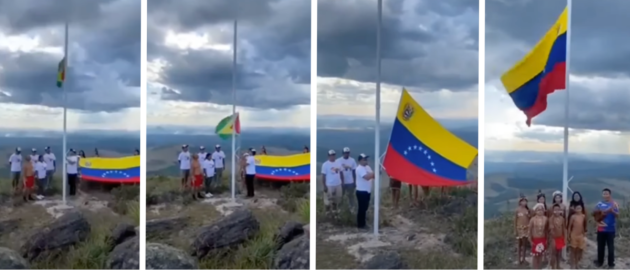
Geolocation of Video Two was more difficult due to the poor quality of the video and the size of the area that had to be covered in the manual search of satellite images for relevant features. Starting from areas near the border between Venezuela and Guyana did not result in successful geolocation.
One of the Bellingcat Discord members suggested expanding our search further by citing a Telesur report that claimed the flag-raising ceremony was filmed in the Sierra da Paracaima mountain range and that the participants were indigenous Pemon people from an area near the town of Santa. Helena de Wyren.
A follow-up post by X also suggested that Video Two was filmed in the mountains of Paracaima, although the user baselessly claims that the president of Guyana raised the flag there.

A search for matching objects on satellite images near Santa Elena de Wairen yielded a match on Google Earth at ( 4.68988,-61.23782 ). A key detail was the shape of the forest in the distance. The camera faces southwest.
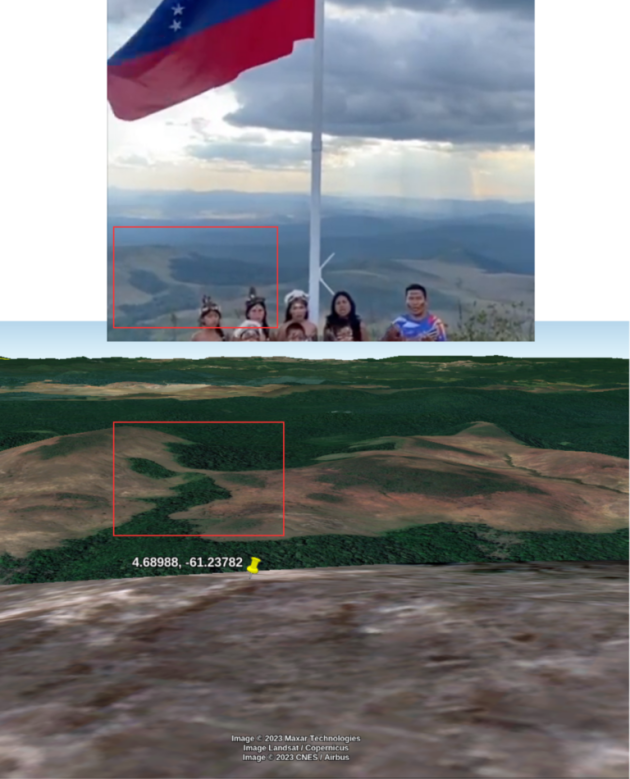
Despite the similarities between the two videos, the claim that they show the same location is inconsistent with available open source evidence. Not only are there differences in the surrounding landscape, but the flagpoles also appear distinct upon closer inspection.
For example, the connector can be seen on the flagpole in the second video. In Video One, such an element is not visible on the flagpole. The Guyanese flagpole also appears taller and is attached to a solid concrete base.

On December 3, Guyana’s news website Demerara Waves published an article on the flag controversy in which the Guyana Defense Force (GDF) called Rodriguez’s tweet and Video Two “misinformation.”
The GDF also said that a gold plaque was installed at the site following a flag-raising ceremony attended by President Ali. The publication Demerara Waves also published a photo of a memorial plaque, the text of which states that the Guyana flag was raised on November 23 at Mount Arau. This sign is one of several items not seen in Video Two, even though it was filmed after Video One.
In total, the Second Video was filmed approximately 185 kilometers from where the Guyana flag was raised as seen in the First Video. The second video was actually taken much closer to the Brazilian border (17 km) than the Guyana border (80 km).
This place is in Venezuela itself, not in the Essequibo area of Guyana, which is claimed by Venezuela.
Although the Guyanese flag can be seen in the second video, it is clearly not the same flag that was raised in the presence of President Ali. Thus, the question remains not only of who ordered the removal of this smaller Guyana flag, but also of who put it up in the first place, especially at a location near the Brazilian border that has no apparent relevance to the current dispute.

